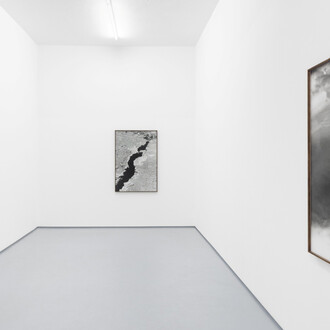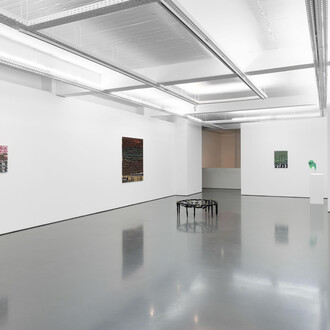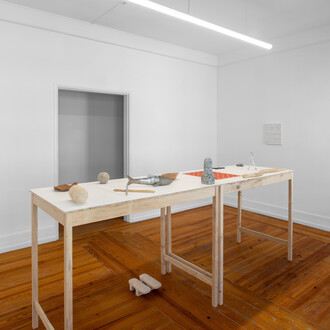Browsing through the exhibition titles Gülbin Ünlü has chosen over the years, one quickly notices they are never incidental. Each one can be understood as a seed, which plants a thought that quietly marks where the artist stands in relation to her work. Taken together, the titles trace the contours of a practice in motion. Read them closely, water them with your own thoughts and they will begin to germinate in unexpected ways. Normal the title of her exhibition at Jahn und Jahn, can be read as a provocation of sorts, immediately raising the question: what does it mean for something to be normal? Is it an ironic nod to the idea that the works on view are representative of the artist’s practice and thus, in a sense, ‘normal’? A critical reflection on the very notion of normativity? Or simply a word that travels easily across languages – a title that makes no claim beyond being a word tossed into the air, open to whatever meaning lands with it? While artists are so often expected to provide answers to such questions, I’d prefer to grant them the liberty of not having to. Words and artworks alike should remain open – because if meaning were fixed, where would all your own impressions have room to go?
It is precisely this idea of a state of flux that runs through Ünlü’s practice. In a recent conversation, she told me that anything remaining within her proximity, meaning within the walls of the studio – and even works returned from a museum show – inevitably becomes material she continues to engage with. Some paintings accumulate new layers; others are stripped back. This approach is grounded in an understanding that the world we inhabit is shaped by movement – by people (having to) migrate from one place to another, by overlapping timelines, and by the personal and political entanglements that arise from these shifting conditions. For any artist working primarily within the realm of painting, motion is fundamental: the speed and pressure of the brushstroke directly influence the intensity of the color. In Ünlü’s case, she has developed a pictorial technique that reflects this dynamism – one that merges painting with printing, canvas, and glitter with oil.
There is no hierarchy of materials – no single element holds more value than another. In a similar vein, her works can stand on their own or function as part of larger constellations. It enables the singular to become part of a whole, while always retaining the potential to break away again. For many of her works, Ünlü begins by composing images digitally – or by translating analog collages, archives, drawing and painting into digital form. From this growing archive, she selects fragments, prints them onto film, and transfers them – still wet – onto canvas or fabric. What emerges is never final: the surface remains a site of return, reworked by hand – gesture by gesture – with the brush. Within the exhibition, this technique is particularly evident in the three paintings Transit: locked, Transit: unseen, and Transit: unheard (all 2025), where white, undefined bodies move through richly colored interiors and landscapes: they walk a path, stand near water, or float on a boat. Composed in distinct horizontal registers, the works unfold like layered fragments of memory or myth. The blur – a result of Ünlü’s intervention while the surface is still fluid – lends the images a haunting quality. Figures don’t simply move through space – they reverberate within it. Like scenes glimpsed through fabric or time, the images linger – just long enough – before dissolving.
It’s within this suspended state that Ünlü’s engagement with film and music also takes root, deepening the resonance already present on the surface. While some references are apparent in the titles themselves – such as Guilty feet have got no rhythm (2023), lifted from George Michael’s Careless whisper, or Don't believe the hype it’s sequel (2023), echoing the eponymous track by Public Enemy – others are less explicit. Ünlü’s works operate like visual samples, fragments pulled from multiple sources, layered and recombined to form something new. These ideas come into focus in the series Silent running (2025), whose individual paintings operate as affective habitats – fragments of a speculative garden, suspended somewhere between memory and afterlife. The reference to the 1972 film of the same name is not literal, but tonal: a cinematic echo of post-anthropocentric care and the persistence of life in artificial ecologies. Within the logic of painting, these works resist resolution. They offer no center but only layers and the suggestion of vegetal presence as something felt, not shown.
This logic continues architecturally in the installation karanlık ışık (2025), a walk-through composition of layered textiles. Created on site for the project space of the gallery, it invites visitors to pass through soft thresholds – transparent, absorbent, and responsive. Each layer becomes a screen, a membrane, a pause. As an artist deeply attuned to spatial relationships, it is no surprise that this thinking carries beyond the gallery’s interior space: the final gesture of “normal” leads into the garden behind the building. The gesture is modest, yet it extends beyond the human. Para os que passam (2025) – for those passing through – is an invitation to all life forms that inhabit the garden: people, animals, plants. It is a small opening in time, but one that echoes the looping structures at the heart of Ünlü’s work – where nothing vanishes entirely, and everything, in some form, returns.
(Text by Carina Bukuts)














